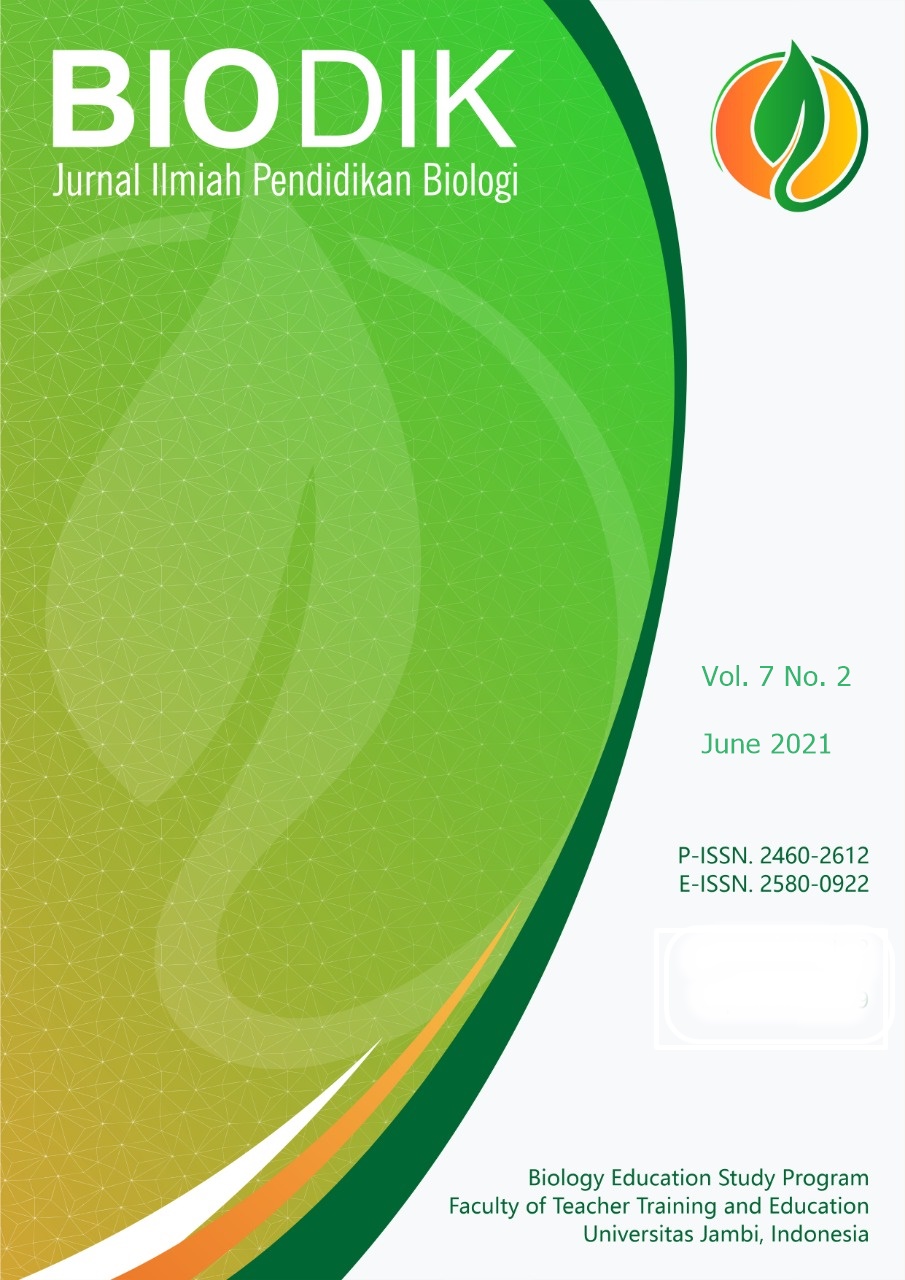Profil Hasil Belajar Kognitif Siswa Dengan Metode Blended Learning Pada Materi Sistem Pernapasan Manusia
(Profile of Student Cognitive Learning Results With The Blended Learning Method in Human Respiratory System Materials)
DOI:
https://doi.org/10.22437/bio.v7i2.12813Abstract
Cognitive learning outcomes are the student's ability to understand a concept expressed in a score through a test. Cognitive learning outcomes are important learning outcomes as the basis for mastery of other abilities. The purpose of this study was to determine the cognitive learning outcomes of class XI IPA 2 students on the material of the human respiratory system. The research method used is a qualitative method using an instrument in the form of a multiple choice written test. The research was conducted on March 22, 2021. The subjects of this study were class XI IPA 2 with a total of 30 students. The data obtained is the result of students' cognitive learning on the material of the human respiratory system. The results obtained by an average value on the material of the human respiratory system are 27% of students in category A, 17% in category B, 30% with C criteria and 26% with D criteria. thus providing the achievement of better cognitive learning outcomes, the obstacle is the lack of direct interaction between educators and students.
Abstrak.
Hasil belajar kognitif merupakan kemampuan siswa dalam memahami suatu konsep yang di nyatakan dalam sebuah skor melalui tes. Hasil belajar kognitif merupakan hasil belajar yang penting sebagai dasar penguasaan kemampuan lainnya. Tujuan penelitian ini untuk mengetahui hasil belajar kognitif siswa kelas XI IPA 2 pada materi sistem pernapasan manusia. Metode penelitian yang digunakan metode kualitatif dengan menggunakan instrumen berupa tes tertulis pilihan ganda. Penelitian di lakukan pada 22 Maret 2021. Subjek penelitian ini adalah kelas XI IPA 2 dengan jumlah sebanyak 30 siswa. Data yang di peroleh merupakan hasil belajar kognitif siswa pada materi sistem pernapasan manusia. Hasil yang di peroleh rata-rata nilai pada materi sistem pernapasan manusia yaitu 27% peserta didik berkategori A, 17% berkategori B, 30% berkriteria C dan 26% berkriteria D. Penggunaan metode Blended learning membantu peserta didik dalam menambah pengetahuan yang lebih luas, namun kendalanya adalah kurangnya interaksi secara langsung antara pendidik dan peserta didik.
Downloads
References
Ahmad, K. A. (2017). Analisis Kajian Konseptual Model Pembelajaran Blended Learning berbasis Web dalam Meningkatkan Hasil Belajar dan Motivasi Belajar. Jurnal Pendidikan Edutama, 4(2), 51–64.
Aslamiyah, A. T., Setyosari, P., & Praherdhiono, H. (2019). Blended Learning Dan Kemandirian Belajar. Jurnal Kajian Teknologi Pendidikan, 2(2), 109–114. https://doi.org/10.17977/um038v2i22019p109
Fiteriani, I., & Baharudin. (2017). Analisis Perbedaan Hasil Belajar Kognitif Menggunakan Metode Pembelajaran Kooperatif yang Berkombinasi Pada Materi IPA. Jurnal Pendidikan Dan Pembelajaran Dasar, 2(2), 1–30.
Handayani, T., Widyaningsih, S. W., & Yusuf, I. (2017). Penggunaan model pembelajaran kooperatif tipe Snowball throwing terhadap hasil belajar Peserta didik. Curricula: Journal of Teaching and Learning, 2(1), 47–58.
Hardianti, T. (2018). Analisis Kemampuan Peserta Didik Pada Ranah Kognitif Pada Mata Pelajaran Fisika SMA. 25, 557–561.
Ibda, F. (2015). Perkembangan Kognitif Jean Piaget. Intelektualita, 3(1), 242904.
Idris, I. S. (n.d.). Biology Teaching and Learning Analisis Kebutuhan Pengembangan Blended. 101–108.
Khoiroh, N., Munoto., & Anifah, L. (2017). Pengaruh Model Pembelajaran Blended Learning dan Motivasi Belajar Terhadap Hasil Belajar Siswa. Jurnal Penelitian Ilmu Pendidikan, 10(2), 97–110.
Kurniawati, M., Santanapurba, H., & Kusumawati, E. (2019). Penggunaan Metode Blended Learning Menggunakan Model Flipped Classroom Dalam Pembelajaran Matematika SMP. EDU-MAT: Jurnal Pendidikan Matematika, 7(1), 8–19. https://doi.org/10.20527/edumat.v7i1.6827
Nasution. (2011). Berbagai Pendekatan Dalam Proses Belajar dan Mengajar. Bumi Aksara.
Ramadhan, F., Mahanal, S., & Zubaidah, S. (2017). Meningkatkan Hasil Belajar Kognitif Siswa Melalui Model Pembelajaran Biologi Remap STAD. Jurnal Pendidikan, 2(5), 610–615.
Setyoko, S., & Indriaty, I. (2018). Penerapan Pembelajaran Problem Based Learning Berbasis Blended Learning terhadap Hasil Belajar Kognitif dan Motivasi Mahasiswa. Jurnal Pendidikan Biologi, 7(3), 157. https://doi.org/10.24114/jpb.v7i3.10433
Sudjana.N. (2009). Penilaian Hasil Proses Belajar Mengajar. Remaja Rosdakarya.
Sugiyono. (2016). Metode Penelitian Kuantitatif, Kualitatif dan R&D. Bandung: PT Alfabet.
Suprapto, S., Zubaidah, S., & ... (2018). Pengaruh gender terhadap keterampilan berpikir kreatif siswa pada pembelajaran biologi. … , Dan Pengembangan, 1, 325–329. http://journal.um.ac.id/index.php/jptpp/article/view/10642
Wardani, D. N., Toenlioe, A. J. E., & Wedi, A. (2018). Pengembangan Daya Tarik Pembelajaran Di Era 21 Dengan Blended Learning. Jurnal Kajian Teknologi Pendidikan (JKTP), 1(1), 13–18. https://core.ac.uk/download/pdf/287323676.pdf
Downloads
Published
Versions
- 2020-06-02 (2)
- 2021-06-02 (1)
How to Cite
Issue
Section
License
Copyright (c) 2021 Ellen Nurlindayani, Setiono, Suhendar

This work is licensed under a Creative Commons Attribution-NonCommercial-ShareAlike 4.0 International License.
Copyright Notice
Authors who publish with Biodik : Jurnal Ilmiah Pendidikan Biologi agree to the following terms:
- For all articles published in Biodik : Jurnal Ilmiah Pendidikan Biologi, copyright is retained by the authors and grant the journal right of first publication with the work simultaneously licensed under a Creative Commons Attribution-ShareAlike 4.0 International Licensethat allows others to share the work with an acknowledgment of the work's authorship and initial publication in this journal.
- Authors are able to enter into separate, additional contractual arrangements for the non-exclusive distribution of the journal's published version of the work (e.g., post it to an institutional repository or publish it in a book), with an acknowledgment of its initial publication in this journal.
- Authors are permitted and encouraged to post their work online (e.g., in institutional repositories or on their website) prior to and during the submission process, as it can lead to productive exchanges, as well as earlier and greater citation of published work (See The Effect of Open Access).
















